Related Research Articles
The history of Guam starts with the early arrival around 2000 BC of Austronesian people known today as the Chamorro Peoples. The Chamorus then developed a "pre-contact" society, that was colonized by the Spanish in the 17th century. The present American rule of the island began with the 1898 Spanish–American War. Guam's history of colonialism is the longest among the Pacific islands.
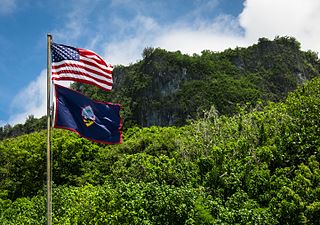
Stand Ye Guamanians, officially known as the Guam Hymn, is the regional anthem of Guam. The original English lyrics and music were written and composed in 1919 by Ramon Manilisay Sablan. The lyrics were slightly modified by the U.S. government prior to official adoption in 1952. In 1974, Lagrimas Untalan translated the English lyrics into CHamoru, which were made official in 1989. The CHamoru version is more widely used today.

Chamorro is an Austronesian language spoken by about 58,000 people, numbering about 25,800 on Guam and about 32,200 in the Northern Mariana Islands and elsewhere.

The Chamorro people are the Indigenous people of the Mariana Islands, politically divided between the United States territory of Guam and the encompassing Commonwealth of the Northern Mariana Islands in Micronesia, a commonwealth of the US. Today, significant Chamorro populations also exist in several U.S. states, including Hawaii, California, Washington, Texas, Tennessee, Oregon, and Nevada, all of which together are designated as Pacific Islander Americans according to the U.S. Census. According to the 2000 Census, about 64,590 people of Chamorro ancestry live in Guam and another 19,000 live in the Northern Marianas.
The music of Guam encompasses a broad range of traditional and contemporary music. Modern music from Guam includes elements of American, Spanish, Filipino and Polynesian music. The Spanish and Mexicans contributed a type of song called serenatas to the culture of Guam. Some traditional Catholic songs in the Spanish language, including "Mil Albricias", "Pastores a Belen", "Santa Maria de la Merced" or "En Lecho de Pajas" and some traditional love songs including "A mi morena", "Ay que triste desventura", "Cancion de Antonio Acosta" or "Te quiero amar" are preserved. Flora Baza Quan is known as the "Queen of Chamorro Music". The state song of Guam is "Stand Ye Guamanians" by Ramon Sablan, adopted in 1919, but better known as the 1974 Chamoru translation by Lagrimas Untalan, "Fanohge Chamoru."
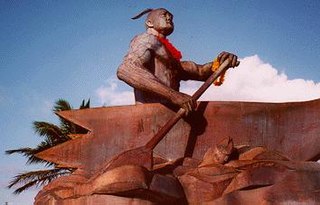
Gadao is a legendary chief of the village of Inarajan in southern Guam. In the Chamorro language of ancient Guam, he would have had the title maga'lahi as a high-ranking male. In addition to being featured in legend, he is the namesake of Inarajan's Chief Gadao's Cave containing ancient cave paintings. Some stories claim Gadao himself drew the figures. It is also said he was a kind giant that fought to protect his island home at all costs.
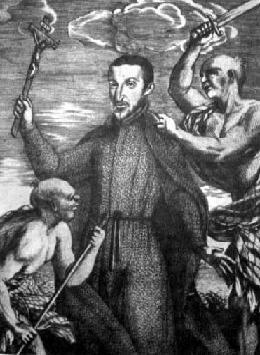
Matå'pang was a Chamorro maga'låhi or chief of the ancient Chamorro village of Tomhom on the island of Guahan. His name meant "to be made pure by cleansing" in Chamorro.

Guam Public Library System is the public library system of the United States territory of Guam. The main library is the Nieves M. Flores Memorial Library at 254 Martyr Street in the village of Hagåtña.

The culture of Guam reflects traditional Chamorro customs in a combination of indigenous pre-Hispanic forms, as well as American and Spanish traditions. Post-European-contact CHamoru Guamanian culture is a combination of American, Spanish, Filipino and other Micronesian Islander traditions. Few indigenous pre-Hispanic customs remained following Spanish contact, but include plaiting and pottery, and there has been a resurgence of interest among the CHamoru to preserve the language and culture. Hispanic influences are manifested in the local language, music, dance, sea navigation, cuisine, fishing, games, songs and fashion.

Craig Santos Perez is a poet, essayist, former university professor, American publisher (USA) from the Chamorro people, born in Mongmong-Toto-Maite, Guam Island. His poetry has received multiple awards, including the 2023 National Book Award, a 2015 American Book Award and the 2011 PEN Center USA Literary Award for Poetry.
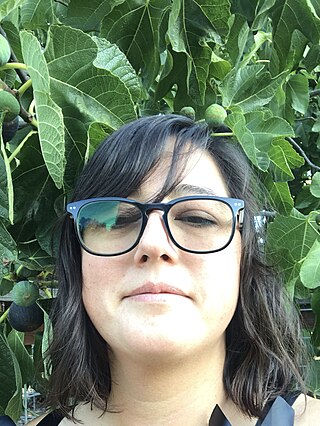
Lehua M. Taitano is a Chamoru poet, interdisciplinary artist, and educator. She is an indigenous person of the Mariana Islands, which are referred to as Laguås yan Gani in the Chamorro language.

Latte Stone Park, officially Senator Angel Leon Guerrero Santos Latte Stone Memorial Park, is an urban park in Hagåtña, Guam. Established in the 1950s and operated by the Guam Department of Parks and Recreation, it is best known for its set of eight historical latte stones, which were transferred from their original site in Fena. The Park is located along the cliffline below the Governor's residence in Agana Heights and south of the Plaza de España. It is often visited by sightseers visiting central Hagåtña. The park also includes the entrances to two sets of caves that were constructed during the Japanese occupation (1941–1944) by forced laborers and that were listed in the National Register of Historic Places in 1991 as the Agana/Hagåtña Cliffline Fortifications.
Laura Maud Thompson was an American social anthropologist best known for her studies of CHamoru culture in Guam. She studied many cultures around the world, including many Native American nations, with the self-professed aim of "trying to build an integrated theory of human group behavior that was grounded in actual behavior and relied on rigorous methods of verification to ensure reliability." She was the recipient of the 1979 Bronislaw Malinowski Award from the Society for Applied Anthropology.
Agualin, sometimes Aguarin or Diego de Aguarin, was a Chamorro chief who led a siege of Hagåtña (1676–1677) on Guam during the Spanish-Chamorro Wars. This was the second of three unsuccessful sieges of the Spanish presidio carried out by CHamorus seeking to eject the colonial presence, with the final widespread violence on Guam in 1683. While Spanish colonial history vilified Agualin as being anti-Christian and anti-civilization, a modern reevaluation reframes Agualin as a champion of CHamoru nationalism.
An epidemic of smallpox in 1856 on the west Pacific island of Guam, then under the control of Spain, resulted in the death of over half of the population, or about 4,500 people. The population collapse led Spanish authorities to transfer the population of Pago to Hagåtña, ending a settlement dating back before colonization. It also led the Governor of the Spanish Mariana Islands to encourage immigration to Guam.
Sabina Eileen Flores Perez is a Guamanian educator and politician. Perez serves as a Democratic senator in the Guam Legislature.
Hope Alvarez Cristobal is a Guamanian educator, activist, politician, farmer, and museum director. Cristobal is a former Democratic senator in the Guam Legislature. Cristobal is known for advocating for indigenous rights of the Chamorro people.
Katherine Bordallo Aguon is a Guamanian educator and politician. Aguon is a former Republican senator in the Guam Legislature.
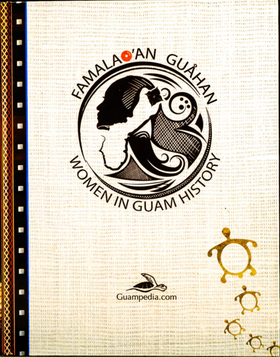
Famalao’an Guåhan: Women In Guam History is a 2019 publication highlighting the lives of 28 notable women who contributed to Guam's culture. The book was the second printed publication from Guampedia, a non-profit associated with the University of Guam.
Agueda Johnston was a Chamorro educator, known as the "Mother of Guam's Education". She was instrumental for Guam's Liberation Day to be recognized by the authorities of the island as a festive holiday.
References
- 1 2 Steffy, Rlene Santos (5 June 2017). "Michael Lujan Bevacqua: History within the CHamoru context". The Guam Daily Post. Retrieved 2022-05-22.
- 1 2 3 4 5 6 7 8 9 "» Michael Lujan Bevacqua". www.guampedia.com. 5 October 2009. Retrieved 2022-05-22.
- 1 2 3 "Dr. MICHAEL LUJAN BEVACQUA on Guåhan's Sovereignty Amidst Climate Change /243". FOR THE WILD. 21 July 2021. Retrieved 2022-05-23.
- ↑ "Dr. Michael Lujan Bevacqua". American Civil Liberties Union. Retrieved 2022-05-24.